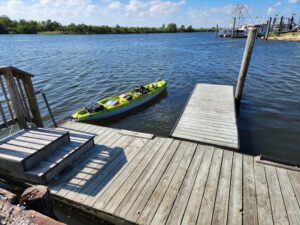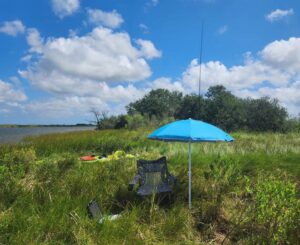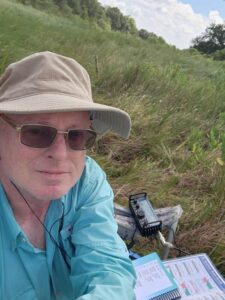Shepherd State Park POTA Campout
Jackson County ARA (JCARA) coordinated a POTA Campout event. The event was held during the weekend of November 17-19, 2023 at the Shepard State Park, Gautier, MS.
We arrived Friday to setup camp and Saturday went “Radio Active” with POTA contacts. We had three POTA stations, three types of antennas, two different modes (Phone/FT8), and four operators.
What is POTA? POTA (Parks On The Air) is a great ham radio past-time. POTA came from a highly successful ARRL NPOTA (National Parks on the Air) year long event in 2016. This ARRL event was co-sponsored by the US NPS (National Park System) for the 100th anniversary of our National Parks. NPOTA was so successful, there was interest for something more. POTA was the results of the demand and was create as an organization in 2018. Since 2018 POTA been growing by leaps and bounds.
Let me describe how POTA works. There are Activators (who are onsite at a designated park), stand-up an antenna(s), radios, and start to make contacts. There are rules, but mainly all gear, and operator must be entirely in a park. Any contact will qualify, but there is a special type of contacts called Hunters who tries to contact any Activator in the parks. Both Activators and Hunters, get awards for making contacts. Refer to the Parks On the Air website (ParksOnTheAir.com) for more information. Only parks listed in POTA qualifies.
All four of us working the POTA event became activated. You need at least ten contacts for a successful activation. I had previously activated Shepard State Park, so it did not count towards my next POTA Activator award. However, it is always fun. The other operators onsite had there very first POTA activation.
One activator, Austin White (AE5MU), had 106 contacts by phone on 20m. I helped him log his contacts, and he basically had a pile-up for at least an hour.
We had a great Campout at Shepard State Park (POTA K-2551), and a great POTA activation.
We have plans to make POTA larger, multi-park, a Mississippi event. It is my fondest wish, that other operators around the great state of Mississippi, join us for POTA events, and enjoy the outdoors by visiting the parks.
Jerry Davis, WF5W
Member, Jackson County Amateur Radio Association
Jackson County, MS
Here are pictures of W5SMN’s campsite. His antenna is a DIY (fabricated) from parts in the garage. The base platform was provided by a neighbor down the street.
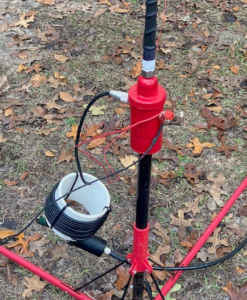
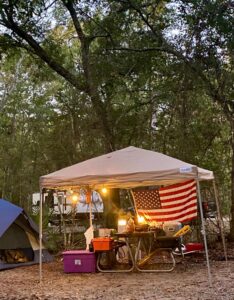
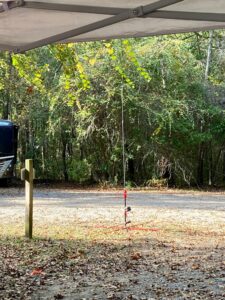

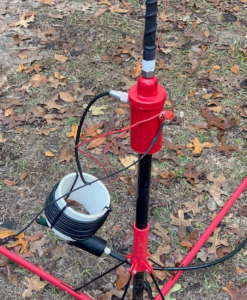


New POTA Park: K-9849, Deer Island Coastal Park
This new park was added recently. And, of course 3 of our own just HAD to activate it!
So, on Thursday, October 26, 2023, Jerry – WF5W, Mike – KG5KSA, and Dane – KI5TDZ were ferried across, by another Member of our Club, Kevin – KD4YMX. We had a little bit of a time, erecting the antenna we had, because of the wind, but once we did, it was off to the races.
We got 19 FT8 contacts, and 12 Phone contacts on 20m. We also got a 2m (146.55) contact with Matt – KD5LOH, yet another member of our club!
We brought quite a bit of gear with us:
- antenna with heavy duty tripod
- portable table, and 3 chairs
- Xiegu x6100
- Laptop
- 2 LifePO4 batteries
To make sure we got our 10 contacts, we did a number of them on FT8. Once our Activation was assured, we switched to 20m USB to do some phone work. We got CO, FL, KY, MN, MS, NC, SD, and TX. Not bad on 10 Watts and a Wire!
Congratulations to Jerry, who has the honor of being the very first activator of this park!
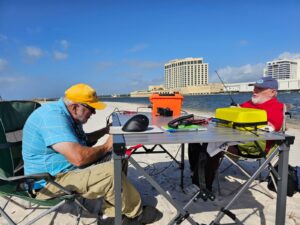
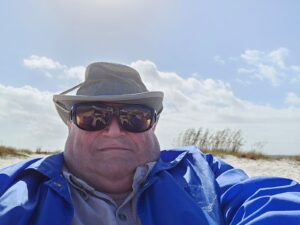
Jerry Noble’s Great (POTA) Adventure
On Saturday, the 30th of September, Jerry Nobles, N5MES, kept up his long-held tradition of always doing things the hard way. Activating a Parks On The Air (POTA) should be easy – right? But he wanted to activate a park that had never been activated before. Jerry said the dumb idea really formed last year during the weekend of the Huntsville Hamfest after he had activated a Summits On The Air (SOTA) that had never been activated before. That had taken a few months of planning and a letter-writing campaign to find someone that would grant permission to access their land. Finally, a response came from the owner of the summit at Drake Mountain in Alabama. She and her friend at the Land Trust of Alabama corresponded with Jerry through email and they told him where to park and the hazards to avoid. After hiking over a literal mile-and-a-half through rocks, brush, and heat he finally made it to the summit. 10 contacts later (one from France!) it all paid off and the thrill of the adventure remains.
But what to do next? POTA is immensely popular on the Gulf Coast (alas, there are no summits here), and public parks are by design very easy to access. So all the parks have been activated, right? Well, to find that out, he went to the pota.app website and found the menu for the Park List. Searching for Mississippi parks and then sorting by number of activations, he discovered that every park in Mississippi had been activated at least once. The same was found to be true for Alabama and Florida. But Louisiana had five parks that had never been activated! The reason that these parks had never been activated was because they aren’t parks in the traditional sense – they are Wildlife Management Areas (WMA’s) that are only accessible by boat. Jerry not being a fisherman or mariner in general, this was a problem. There were WMA’s that were a couple of miles from a public boat launch and thus within reach by kayak. So, off he went to Keesler Air Force Base to rent a kayak and cruise around their marina to see if kayaking was feasible. It seemed to be promising.
Slowly, he began collecting gear to be able to activate a park via kayak. He had plenty of time because he did not want to set out on an adventure like that in the hot, humid, Gulf Coast summer, so he made plans to go next fall during the cooler weather. He purchased an Elecraft KX2 in March after a payout from working extra hours. The KX2 is a dream portable radio. With 10 watts, an automatic antenna tuner, and an SDR receiver that boasts benchtop specs and features, it is an ideal POTA/SOTA radio. Jerry had a robust 40’ mast but it was much too heavy (and long) to pack, so his wife (KH7PB) let him get a 32’ TN07 mast. That mast was introduced to him by KM4ACK at Monte Sano State Park in Huntsville. It was lightweight, 4.3 lbs., and relatively short, 45”, when packed down. Jerry had a 40-meter End Fed Half Wave (EFHW) antenna that he had won at the 2022 Jackson County Hamfest, but it was still unassembled in the box. So that was unboxed, soldered up, and tested.
The panic didn’t set in until the other Jerry, WF5W, texted him in mid-September with a link to a Facebook post about some Louisiana amateurs activating the “easiest” park to get to, Salvador WMA K-4079. (United States parks have a K suffix and a four-digit serial number.) The only other park easily accessible by kayak was the Biloxi WMA, K-4050, so he knew he had to activate it immediately before the guys with motorized fishing boats got to it.
It was a two-and-a-half-hour drive to the Hopedale Marina, then a 2.85 mile kayak trip to the park boundary. The POTA rules say that one’s entire setup must be within the park boundaries. The boundaries that one is to go by are published by the state or national authorities. At the official website for the Biloxi WMA, Jerry found the official boundary map, and instructions to purchase an annual pass. You must have a pass and do a self check-in on their website to access the WMA. Jerry also paid the $5 kayak launch fee at the marina, loaded up the sleek vessel and set off against a fierce headwind.
Yes, on the map above is the Garmin watch data for the trip out. It was a steady 14 mph wind almost head-on. At times he felt like he was going nowhere, and if Jerry stopped paddling, he would go backwards! While crossing the open water of the old MRGO, he almost turned back thinking he didn’t want to get too exhausted and then not be able to set up, operate, and get back before dark.
After putting his head down and trying to ignore the time, a beautiful sight eventually came into view, the park boundary marker!
Not long after the boundary marker was sighted, he pulled off to the south side of the channel to a swampy, marsh grass clearing. Even though the rig was in a water-resistant box and the supplies were in a dry bag, he was very, very careful while beaching the kayak and dragging it ashore. Surveying the area, Jerry decided to not hoist the antenna up into the small trees at the edges of the clearing – he would just use the top of the 32’ mast for the end of the antenna and let the wire slope down to the 49:1 unun atop the marsh grass. He stretched out the 20’ coax to the folding chair and set up the beach umbrella. It was at that point that he realized he had forgotten to eat! A quick snack and water somewhat satiated the hunger and thirst – there was much more important stuff to do!
Yeah, the beach umbrella lasted about 2 minutes in that wind. TN07 in the background.
Jerry had a cell phone signal, but it was not strong enough to load the pota.app website to spot himself or to make a phone call. Jerry was able to text message Mark, W5LPZ, but Mark didn’t reply. So, he fired up the KX2 on 20 meters to the lower part of the voice portion of the General band and the ATU loaded it up quickly. Slowly scanning upward he heard KB4QXI calling CQ – he was at park K-2187 in Northwest Georgia and they exchanged 55 signal reports. The first contact was a park-to-park! After a few more hunt-n-peck contacts Mark texted back and said that he had just gotten off the mower. Jerry heard Mark’s call on the selected frequency, but Mark could not hear Jerry with just 10 watts. However, Mark was able to spot Jerry on the pota.app website and shortly thereafter the calls started coming in!
After a while, with 29 SSB exchanges, there came a call that was completely unexpected. Even with headphones on, he heard a pretty loud squeal from a wild hog that must have been close. At that instant Jerry realized what those rather large droppings were that he had seen earlier. Popping up quickly, Jerry was unable to see any hogs in the thick marsh grass. But the warning was heeded. Jerry knew that it was time to pack up. Jerry text messaged Mark to QSY to 40 meters and they were able to make the last contact of the park activation.
After loading up and packing out, (always leave a site cleaner than when you found it), there was still a strong wind from the East Northeast. It felt like an outboard motor was attached compared with that earlier headwind! Getting back to the marina only took 56 minutes even though it took much less paddling effort than before!
After the exciting day was over, some things that Jerry noted were:
He forgot his 2m HT at the house. It also can receive VHF Marine frequencies,
A clipboard and larger paper would have made writing down the contacts easier,
A pre-printed log sheet would have been even better,
And a larger hog gun would have been more comforting.
Now that his first POTA activation is in the history books, Jerry is looking forward to more normal POTA activating and POTA hunting from the QTH – to help those that make the effort to get to a park and set up and call CQ. He really wants to thank the other Jerry, WF5W, for his excitement and encouragement for getting parks activated, and Mark, W5LPZ, for spotting him and for the contact and advice.
While not every POTA can be this exciting (or difficult), just getting out of the shack and testing out different setups is sure to keep the sense of adventure fresh. There are many wonderful parks out there and many different ways to activate. We look forward to hearing more about POTA adventures from the members of the Jackson County Amateur Radio Association. Catch you on the air!
73 from N5MES and JCARA
Gulf Islands National Seashore:
A recent P.O.T.A. to remember. One fine spring day, after weeks of “cabin fever” due to prolonged winter weather; Joe, W5DDX, Jim, W5SMN, Jerry WF5W (and Spouse Ellen) – a great representation of the Jackson County Amateur Radio Association, JCARA, lit up the Gulf Islands National Sea Shore park with RF to make HF contacts and and enjoy the comradery.
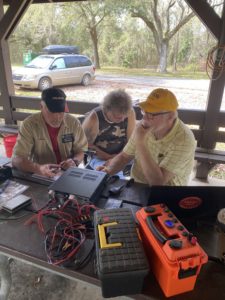
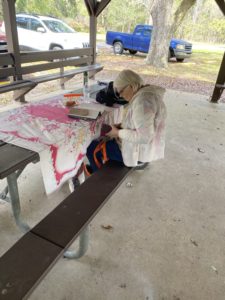
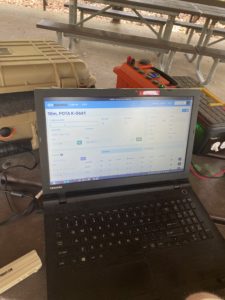
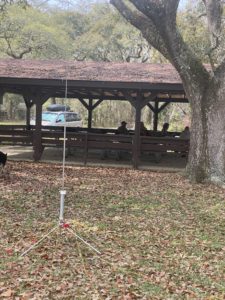
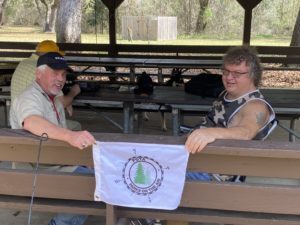
And … Calling CQ, CQ, CQ DE W5DDX via the 5BVJY five band Vertical Antenna. Watch the YouTube video for more information. Oh, be sure to share the video to encourage Joe and others to give a second life to well used “parts and pieces.” Thank you Joe for sharing with the rest of us. Additional thank you to W5SMN, WF5W, W5DUI and WG5GK for the field video production and QA/QC services.


